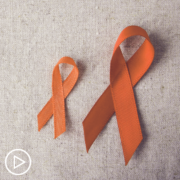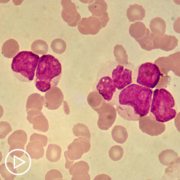What Does Triplet Therapy in AML Mean for the Future?
What Does Triplet Therapy in AML Mean for the Future? from Patient Empowerment Network on Vimeo.
What do acute myeloid leukemia (AML) patients need to know about triplet therapy? Dr. Naval Daver from the University of Texas MD Anderson Cancer Center shares his perspective. Learn about the meaning, progress, and outlook for triplet therapy.
[ACT]IVATION TIP from Dr. Daver: “Some of the early data with the FLT3 inhibitor as well as the CD47 antibody triplets are showing very, very promising activity and are now moving into larger multi-center and randomized studies.”
Download Resource Guide en español
Related Resources:

What Are Some Clinical Predictors for Relapse in Acute Myeloid Leukemia? |

|

|
Transcript:
Art:
Dr. Daver, what does triplet therapy in AML mean for the future?
Dr. Naval Daver:
So when we say triplet therapy, what we’re really thinking about is building on the existing FDA-approved combination of HMA venetoclax (Venclexta), so as a background venetoclax, showed a CR, CRI which is a complete remission rate of about 70 to 75 percent with the median survival in 15 months.
This was in older patients, about 75 years in age, those who were not considered fit for intensive chemotherapy, although this was a major step forward in comparison to what we have seen with traditional low intensities with azacitidine (Onureg or Vidaza), decitabine (Dacogen) alone, we do see the three-year survival is about 25 to 30 percent.
So this is progress compared to 10 percent long-term survival, we used to get a decade ago, but, of course, we want to improve on that. Also, a molecular analysis of data has shown that there are certain molecular subsets that don’t respond as well to azacitidine, venetoclax or if they respond they relapse quickly these include FLT3 mutated and the TP53 mutated as well as potentially MLL rearranged.
And so here we have started incorporating the targeted therapies like inhibitors like the menin inhibitors like CD47 antibodies to target those specific high-risk or bad molecular cytogenetic groups, and we are seeing that with the combinations of these three drugs, especially for those particular molecular subsets.
So azacitidine and venetoclax for FLT3 inhibitor for FLT3 mutator, azacitidine, and venetoclax, magrolimab for TP53 mutated, the response rates that we’re getting, as well as the depth of response and the early trends towards survival are looking very, very promising compared to what we have seen with azacitidine venetoclax alone.
So we believe, and I personally believe that these three drug combinations, the so-called triplets will actually be eventually the way to go forward now, that means that one has to realize that when you add a third drug, there is a cumulative myelosuppression, azacitidine-venetoclax is already a myelosuppressive regimen.
Yes, it’s manageable, but it is myelosuppressive. And the third drug, this can become more cumulative, so we have been working for the last three, four years and continue to work on those optimization because since we are seeing true synergy but pre-clinically and what we think in the clinic, we are not needing to give full doses and we’re doing reduced durations of venetoclax and those with FLT3 inhibitor, and now we feel that some of those triplets are actually giving very, very, very good efficacy.
There’s a lot of discussion in the community of whether we need to combine all two drugs up front or can be sequence these drugs or can we introduce a targeted therapy based on a molecular escape, and I think a lot of these will have to be evaluated and many of these are being looked at in various trials, but I do think the bottom line is that bringing in your targeted therapy or immunotherapies early on in the frontline setting and some way or the other is probably where you’re going to get the most bang for the buck and the most benefit in curing patients long-term rather than trying to reserve them for the salvage, because in salvage AML historically, nothing has really been able to improve the long-term cure rate significantly.
So the activation tip for this question is that now with the identification of certain molecular subsets that have poorer outcomes with the HMA venetoclax, we have started incorporating targeted and immunotherapies in the earlier settings, either up front in the three drug combination or an early sequential approach.
And we believe that with such combinations, we may be able to achieve deeper remission and longer responses. Some of the early data with the FLT3 inhibitor as well as the CD47 antibody triplets are showing very, very promising activity and are now moving into larger multi-center and randomized studies.






